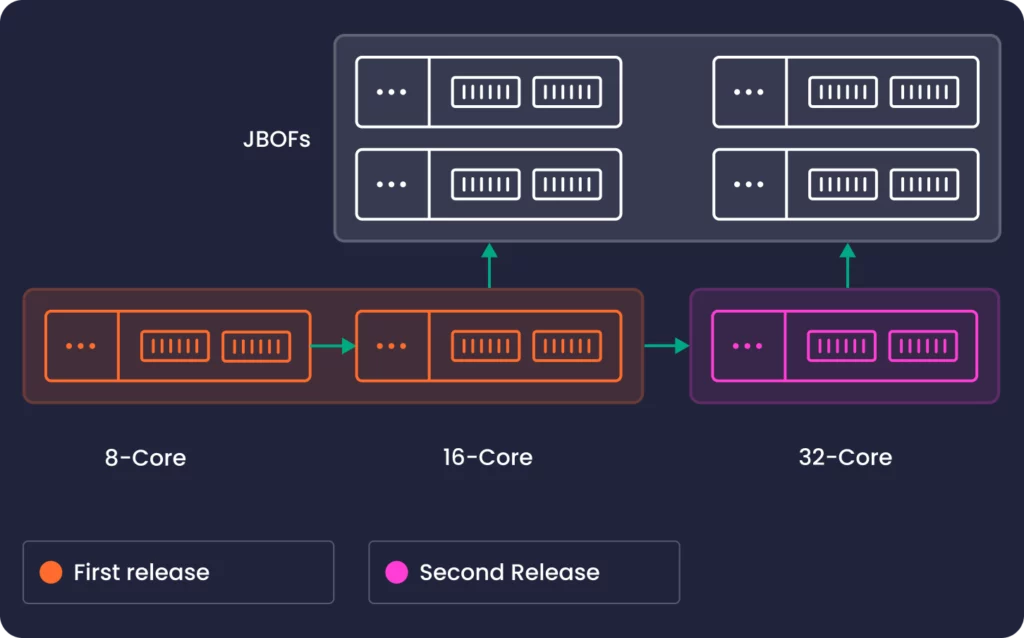Welcome to the final installment in my blog series! Let’s pick up where we left off and delve into the performance-based insights I discovered on the array.
Just as our loan unit arrived with us at Nexstor, HPE announced to partners the latest release of GreenLake for Block Storage. GreenLake for Block is being released in a controlled manner, stage by stage. Release 1 included support for 8-core or 16-core controller nodes with FC or FC/NVMe host ports and no option for JBOF expansion chassis.
Release 2 builds upon that and now supports up to 32-core controller nodes with up to 2 directly connected JOBF expansion chassis.

Support for iSCSI has been added to this release, meaning now we have the following options for Host connectivity:
- 32/64Gb FC or FC/NVMe (1 or 2 Quad port HBAs per controller)
- Ten/25Gbe iSCSI (2 ports controller)
- 100Gb two port HBA for backend connectivity to JBOFs
JBOF hardware
The JBOFs are 2U expansion enclosures, each fitted with 2 JBOF nodes (controllers) running eight-core processors, 64GB RAM, dual port 100Gbe HBA for internode connectivity and up to 24 NVMe drives can be accommodated – same as the Controller enclosures. These can range from 1.92, 3.84, 7.68 or 15.36TB in size.
The switched architecture isn’t here yet; however, that shouldn’t be too far away.
In this latest release, the maximum effective capacity for a system is 1.79PiB (based on a 3:1 deduplication ratio). This will increase over the coming months as further releases are staged. But also bear in mind that this figure is based on enclosure level availability, ensuring that a single enclosure failure does not result in data loss.
I’ve added a screenshot below showing the current performance and capacity maximums for reference.

I won’t list out all the possible configurations and performance permutations; however, to give you an idea of equivalent storage systems in the current HPE portfolio:
- 8 Core 2 node Alletra MP = 3Par 2 Node 7200 through to 2 Node 8400
- 16 core two node Alletra MP = 3Par 4 Node 7400 through to 2 node 8450, Primera 2 Node A630
- 32 core 2 Node Alletra MP = 3PAR 4 Node 8450, 3PAR 2 Node 9450, 3PAR 2 Node 20K, Primera 2 Node A650, Primera 2 Node A670
As I keep saying, into next year, I expect to see further enhancements in performance and scale.
Replication and migration interoperability
The Alletra MP for Block offers Data migration interoperability from HPEs 3Par, Alletra 9000 and Primary using Peer Motion, so system-to-system migration without a 3rd party tool. This will be useful when replacing said arrays with the Alletra MP. Currently, the only transport method supported is Fibre Channel.
HPE Alletra MP for Block: More to come…
So, this is the end of my short blog on the HPE Alletra MP for Block. I will say that I’ve barely scratched the surface when it comes to covering all that it is capable of. One thing is for sure: I believe this will be an epic product, and I’m looking forward to seeing how this develops.
Thanks for following this blog series! If you want to hear more insights on the latest in data storage, check out the Nexstor LinkedIn.
And while you’re at it, our team of experts are always available to assist a business looking to improve their operations via leading solutions. Get in touch and one of our specialists can help you get started.
Share:

